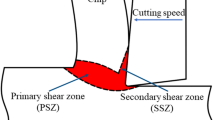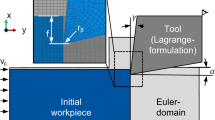Abstract
Modeling and simulation using finite element method (FEM) is a powerful estimation tool and has been greatly helpful to study the metal cutting process, such as investigation of cutting mechanism, optimization of cutting parameters, and design of cutting tools. Thereinto, an effective material model and its parameters are still key problems in the FEM-modeling of metal cutting. In this paper, a 2D FE model for simulating the orthogonal cutting of tungsten carbide WC-17.5Co is developed, in which an inverse identification approach is used to identify the parameters of material model based on orthogonal cutting experiments. The commercially available software DEFORM V11.0 is utilized to develop the FE model, whereas the Johnson–Cook model and Brozzo model are selected as the constitutive model and the fracture model of the work material, respectively. Continuous serrated chip formation is obtained in experiments as well as in FE simulations. The simulated chip morphology, cutting force, and specific cutting force are compared with the experimental results to identify the parameters of the material model. It is found that the chip morphology is more difficult to be used to identify inversely the material model parameters than the cutting force and specific cutting force. The material model parameters are derived, and the verification tests show that there is a close agreement between the simulated and experimental results through comparisons of cutting force and specific cutting force. It indicates that the inversely identified parameters of the Johnson–Cook model and the Brozzo model can be used to describe the mechanical property of tungsten carbide.












Similar content being viewed by others
References
Yaguchi H (2004) The influence of built-up edges on machined surface roughness in low-carbon resulfurized free-machining steel. R&D Res Dev Kobe Steel Eng Rep 54(3):11–15
Liu K, Li XP (2001) Ductile cutting of tungsten carbide. J Mater Process Technol 113(1–3):348–354
Liu K, Li XP, Rahman M (2003) CBN tool wear in ductile cutting of tungsten carbide. Wear 255:1344–1351
Liu K, Li XP, Rahman M (2003) Characteristics of high speed micro cutting of tungsten carbide. J Mater Process Technol 140:352–357
Nakamoto K, Katahira K, Ohmori H et al (2012) A study on the quality of micro-machined surfaces on tungsten carbide generated by PCD micro end-milling. CIRP Ann Manuf Technol 61(1):567–570
Arif M, Rahman M, San WY (2012) Analytical model to determine the critical conditions for the modes of material removal in the milling process of brittle material. J Mater Process Technol 212(9):1925–1933
Arif M, Rahman M, San WY (2013) A study on the effect of tool-edge radius on critical machining characteristics in ultra-precision milling of tungsten carbide. Int J Adv Manuf Technol 67(5–8):1257–1265
Zhan Z, He N, Li L et al (2015) Precision milling of tungsten carbide with micro PCD milling tool. Int J Adv Manuf Technol 77:2095–2103
Ottersbach M, Zhao W (2016) Experimental investigations on the machinability of tungsten carbides in orthogonal cutting with diamond-coated tools. Proc CIRP 46:416–419
Hintze W, Steinbach S, Susemihl C et al (2018) HPC-milling of WC–Co cemented carbides with PCD. Int J Refract Metal Hard Mater 72:126–134
Ma L, Li C, Chen J et al (2017) Prediction model and simulation of cutting force in turning hard-brittle materials. Int J Adv Manuf Technol 91(1–4):165–174
Ceretti E, Fallböhmer P, Wu WT et al (1996) Application of 2D FEM to chip formation in orthogonal cutting. J Mater Process Technol 59(1–2):169–180
Wan L, Wang D, Gao Y (2016) The investigation of mechanism of serrated chip formation under different cutting speeds. Int J Adv Manuf Technol 82(5–8):951–959
Yaich M, Ayed Y, Bouaziz Z et al (2017) Numerical analysis of constitutive coefficients effects on FE simulation of the 2D orthogonal cutting process: application to the Ti6Al4V. Int J Adv Manuf Technol 93(1–4):283–303
Woolmore NJ (2010) The failure of a tungsten carbide–cobalt cored projectile penetrating a hard target. Cranfield University, Cranfield
Hazell PJ, Appleby-Thomas GJ, Herlaar K et al (2010) Inelastic deformation and failure of tungsten carbide under ballistic-loading conditions. Mater Sci Eng A 527(29–30):7638–7645
Moxnes JF, Teland JA, Skriudalen S et al (2010) Development of material models for semi-brittle materials like tungsten carbide. Norwegian Defence Research Establishment (FFI), FFI-rapport 2010/02225
Klocke F, Lung D, Buchkremer S (2013) Inverse identification of the constitutive equation of Inconel 718 and AISI 1045 from FE machining simulations. Proc CIRP 8:212–217
Umbrello D, Hua J, Shivpuri R (2004) Hardness-based flow stress and fracture models for numerical simulation of hard machining AISI 52100 bearing steel. Mater Sci Eng A 374(1):90–100
Yang SB, Xu J, Fu Y et al (2012) Finite element modeling of machining of hydrogenated Ti–6Al–4V alloy. Int J Adv Manuf Technol 59(1):253–261
Warnecke G, Oh JD (2002) A new thermo-viscoplastic material model for finite-element-analysis of the chip formation process. CIRP Ann Manuf Technol 51(1):79–82
Wang Y, Zhou Y, Xia Y (2004) A constitutive description of tensile behavior for brass over a wide range of strain rates. Mater Sci Eng A 372(1–2):186–190
Johnson GR, Cook WH (1983) A constitutive model and data for metals subjected to large strains, high strain rates and high temperatures. In: Proceedings of the 7th international symposium on ballistics, Hague, pp 1–7
Brozzo P, Deluca B, Rendina R (1972) A new method for the prediction of formability limits in metal sheets–sheet metal forming and formability. In: Proceedings of the 7th biennial conference of the international deep drawing research group, Ohio, pp 18–36
Zhang YC, Mabrouki T, Nelias D et al (2011) Chip formation in orthogonal cutting considering interface limiting shear stress and damage evolution based on fracture energy approach. Finite Elem Anal Des 47(7):850–863
Cheng X, Wang Z, Nakamoto K et al (2011) A study on the micro tooling for micro/nano milling. Int J Adv Manuf Technol 53(5):523–533
Filiz S, Conley C, Wasserman M et al (2007) An experimental investigation of micro-machinability of copper 101 using tungsten carbide micro-endmills. Int J Mach Tools Manuf 47:1088–1100
Acknowledgements
This research is financially supported by the National Natural Science Foundation of China under the Contract No. 51475234. What’s more, the authors would like to thank the High-performance Cutting Group in Fraunhofer IPT for the sharing experiment data.
Author information
Authors and Affiliations
Corresponding author
Additional information
Technical Editor: Márcio Bacci da Silva, Ph.D.
Publisher's Note
Springer Nature remains neutral with regard to jurisdictional claims in published maps and institutional affiliations''.
Rights and permissions
About this article
Cite this article
Zhao, W., Yang, Q., Khan, A.M. et al. An inverse-identification-based finite element simulation of orthogonal cutting tungsten carbide. J Braz. Soc. Mech. Sci. Eng. 41, 85 (2019). https://doi.org/10.1007/s40430-019-1568-3
Received:
Accepted:
Published:
DOI: https://doi.org/10.1007/s40430-019-1568-3




